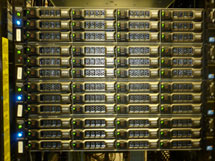
Handy Links
SLAC News Center
SLAC Today
- Subscribe
- Archives: Feb 2006-May 20, 2011
- Archives: May 23, 2011 and later
- Submit Feedback or Story Ideas
- About SLAC Today
SLAC News
Lab News
- Interactions
- Lightsources.org
- ILC NewsLine
- Int'l Science Grid This Week
- Fermilab Today
- Berkeley Lab News
- @brookhaven TODAY
- DOE Pulse
- CERN Courier
- DESY inForm
- US / LHC
SLAC Links
- Emergency
- Safety
- Policy Repository
- Site Entry Form

- Site Maps
- M & O Review
- Computing Status & Calendar
- SLAC Colloquium
- SLACspeak
- SLACspace
- SLAC Logo
- Café Menu
- Flea Market
- Web E-mail
- Marguerite Shuttle
- Discount Commuter Passes
-
Award Reporting Form
- SPIRES
- SciDoc
- Activity Groups
- Library
Stanford
Around the Bay
BaBar Data Archive Prototype Arrives
In preparation for long-term access of its eight-year data set, the BaBar Collaboration acquired four prototype computers at SLAC this month. The machines are now undergoing testing by BaBar computing specialists and the SLAC computing team. A total of sixty machines, containing one petabyte of data from the BaBar experiment, will eventually reside in the SLAC computing building. The Long Term Data Access project, or LTDA, will ensure that data is reliably available and easily accessible through 2018.
The BaBar Collaboration continues to make its home at SLAC National Accelerator Laboratory, although its members are spread across the world. From fall 1999 to spring 2008, the BaBar detector observed collisions between high energy electrons and positrons inside the PEP-II collider. Those collisions produced many events which featured the B meson and its anti-particle, the B-bar meson. The experiment gained the spotlight when, from those events, it measured for the first time a special type of asymmetry between matter and antimatter known as CP violation. The Japanese-based Belle experiment observed the same phenomenon and together BaBar and Belle experimentally confirmed the predictions of one particular theory of CP violation. Following that confirmation, the theory's creators, Makoto Kobayashi and Toshihide Maskawa, were awarded the 2008 Nobel Prize in Physics.
To date, the BaBar Collaboration has published more than 430 papers describing analyses of its huge dataset. BaBar Spokesperson Mike Roney said he expects the collaboration to publish roughly 50 new papers over the next two years, followed by at least an additional 50 before 2018. For this reason, the collaboration began the LTDA project to keep the BaBar data preserved and accessible.
Most experiments, particularly those in particle physics, don't hold onto their data in a fully accessible manner long after they shut down. The time and effort to create a system that keeps the data accessible, plus the cost of storing it, usually outweigh the potential benefits.
"Other experiments have thought about archiving their data," said BaBar Computing Coordinator, Tina Cartaro. "But their data has been outdated by newer experiments." Only one other large particle physics experiment, the H1 particle detector located at DESY in Hamburg, Germany, is attempting a similar data archive.
BaBar possesses one of the most up-to-date and extensive data sets on B physics, and no other new experiment is expected to come close to surpassing it before the end of the LTDA period. BaBar shares that position with the Belle experiment, located at the KEK facility in Japan, which also collected B-meson data during roughly the same time that BaBar did. The two collaborations are jointly producing a book outlining their amassed knowledge on the subject.
The prototype machines that arrived at SLAC this month will primarily offer BaBar Computing Group and the SLAC team the chance to set up appropriate security walls around the data set, which will also protect the SLAC system. The data will be available to users all over the world, and must be secured as the rest of SLAC's computer systems are.
Thirty of the new machines will arrive in June or July of next year, and users will start to switch over to the new system shortly after that. The deployment of the full LTDA system is set to happen on March 21, 2012. The original tapes containing the BaBar data will also remain stored at SLAC, as an additional backup.
"All this is to ensure that BaBar code will be useable in the future; that people will be able to do analyses," Cartaro said. "Three, four, five years from now we can go back and see our data—see if there was a hint of new physics that was not observed before. If some new ideas occur to people or some new discovery is made, for example at the LHC with implications for our data, we can always go back and use the system."
—Calla Cofield
SLAC Today, December 2, 2010
